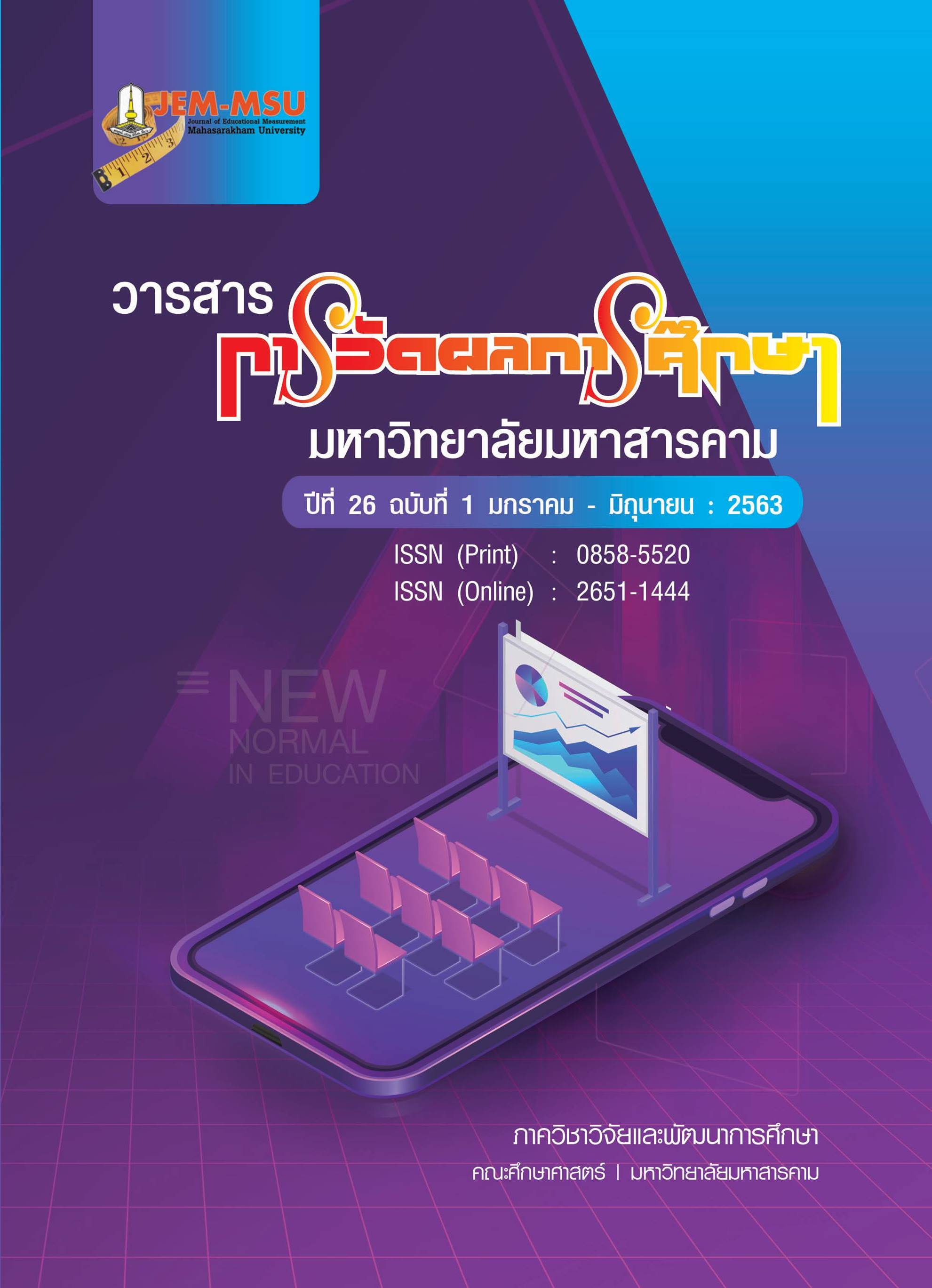Development of Methods of Assessing Problem-Solving Skills in Organizing for Science Learning According to STEM Education Concept for Grade 10
Main Article Content
Abstract
The research objectives were: 1) to build and find the quality of methods of assessing problem solving skills in organizing for science learning according to STEM education concept for grade 10; 2) to develop a manual of methods of assessing problem solving skills in organizing for science learning according to STEM education concept for grade 10. The study was divided into 3 phases: Phase 1 was the study of methods of assessing problem solving skills in organizing for science learning according to STEM education concept, by interviewing 5 experts. Phase 2 was for creating and finding the quality of methods of assessing problem solving skills in organizing for science learning according to STEM education concept, and trying them out with 30 students. Phase 3 was for development of problem solving skills assessment manual. The research instruments comprised an interview form and a suitability assessment form for the manual. Data were analyzed using descriptive statistics: percentage, the mean and standard deviation. The results were as follows:
1. Three methods of problem-solving skills in organizing for science learning according to STEM education concepts were developed: testing, observing and recording.
2. The overall quality of the methods in terms of appropriateness was in the good level.
2.1 The testing method had the method appropriateness in the good level.
1) The two-item subjective test had its content validity ranged from 0.80 -1.00, difficulty from 0.40 – 0.77, discrimination from 0.40 - 0.50, and the reliability was 0.88.
2) The twenty-item objective test had its content validity ranged from 0.60 -1.00, difficulty from 0.60 – 0.70, discrimination from 0.20 - 0.53 and the reliability was 0.79.
2.2 The observing method had the method appropriateness in the good level and the reliability was 0.76.
2.3 The recording method had the method appropriateness in the good level.
3. The overall quality of the assessing manual was in the high level ( = 3.96, S.D.=0.29).
Article Details
The content and information contained in the published article in the Journal of Educational Measurement Mahasarakham University represent the opinions and responsibilities of the authors directly. The editorial board of the journal is not necessarily in agreement with or responsible for any of the content.
The articles, data, content, images, etc. that have been published in the Journal of Educational Measurement Mahasarakham University are copyrighted by the journal. If any individual or organization wishes to reproduce or perform any actions involving the entirety or any part of the content, they must obtain written permission from the Journal of Educational Measurement Mahasarakham University.
References
กระทรวงศึกษาธิการ. (2551). หลักสูตรแกนกลางการศึกษาขั้นพื้นฐาน พุทธศักราช 2551. กรุงเทพฯ : โรงพิมพ์ชุมนุมสหกรณ์การเกษตรแห่งประเทศไทย.
กระทรวงศึกษาธิการ. (2551). ตัวชี้วัดและสาระการเรียนรู้แกนกลาง กลุ่มสาระการเรียนรู้วิทยาศาสตร์หลักสูตร แกนกลางการศึกษาขั้นพื้นฐาน พุทธศักราช 2551. กรุงเทพฯ :โรงพิมพ์ชุมนุมสหกรณ์การเกษตรแห่งประเทศไทย.
กระทรวงศึกษาธิการ. (2549). แนวทางการจัดการเรียนรู้แบบบูรณาการ 2549 ปีแห่งการปฏิรูปการเรียนการสอน. กรุงเทพฯ : โรงพิมพ์คุรุสภาลาดพร้าว.
กุลชลี ตาลช่วง. (2546). การพัฒนาวิธีการประเมินการปฏิบัติงานกลุ่ม สำหรับนักเรียนระดับมัธยมศึกษาตอนต้น .กรุงเทพฯ จุฬาลงกรณ์มหาวิทยาลัย.
จำรัส อินทลาภาพร. (2558). การศึกษาแนวทางการจัดการเรียนรู้ตามแนวสะเต็มศึกษาสำหรับผู้เรียนระดับ ประถมศึกษา. บทความวิจัย : มหาวิทยาลัยศรีนครินทรวิโรฒ.
ปรีชา ช้างขวัญยืน และคณะ. (2542). เทคนิคการเขียนและผลิตตำรา. กรุงเทพฯ: จุฬาลงกรณ์มหาวิทยาลัย.
พรทิพย์ ฉิมพงษ์. (2014). การพัฒนาคู่มือการจัดกิจกรรมการละเล่นเด็กไทยเพื่อส่งเสริมความสามารถทางพหุ ปัญญาของเด็กปฐมวัยในศูนย์พัฒนาเด็กปฐมวัยบ้านครูแมวจังหวัดสมุทรปราการ. สารนิพนธ์ระดับมหาบัณฑิต สาขาวิชาการบริหารการศึกษา มหาวิทยาลัยศรีนครินทรวิโรฒ.
มนตรี จุฬาวัฒนทล. (2558). “รายงานการสัมมนาระดมความคิด เรื่อง STEM Education: นโยบายเชิงรุกในการพัฒนากำลังคนด้านวิทยาศาสตร์ เทคโนโลยี และนวัตกรรม”. สืบค้นเมื่อวันที่ 10 กุมภาพันธ์ 2559 จาก www.senate.genate.go.th.
รัตนา นิธิรักษ์. (2555). การพัฒนาคู่มือระบบการพัฒนาดูแลช่วยเหลือนักเรียนโรงเรียนบ้านท้องคุ้งสังกัด สำนักงานเขตพื้นที่การศึกษาประถมศึกษาสมุทรปราการเขต 2 สารนิพนธ์ระดับมหาบัณฑิต สาขาวิชาการบริหารการศึกษา มหาวิทยาลัยศรีนครินทรวิโรฒ
วิจารณ์ พานิช. (2555). วิถีสร้างการเรียนรู้เพื่อศิษย์ในศตวรรษที่ 21.กรุงเทพฯ: โรงพิมพ์ บริษัท ตถาตาพับลิเคชั่น จำกัด.
วินัย บัวแดง. (2547). การพัฒนาคู่มือการประเมินผลตามสภาพจริงกลุ่มสาระการเรียนรู้ภาษาไทยสำหรับครูประถมศึกษา. กรุงเทพฯ: มหาวิทยาลัยศิลปกร.
เวียงชัย แสงทอง. (2557). การนิเทศการศึกษาเพื่อพัฒนาการจัดกิจกรรมการเรียนรู้ตามแนวทางสะเต็มศึกษา (STEM Education) ของครูวิทยาศาสตร์ระดับประถมศึกษา โดยใช้เทคนิคการนิเทศระบบพี่เลี้ยงและการให้คำปรึกษา (Coaching and Mentoring). บทความวิจัย.สืบค้นเมื่อวันที่ 11 สิงหาคม 2558 ,จาก www.ubon2-ed.go.th./g-news.
อัจฉรา วิญญกูล. (2555). การพัฒนาวิธีประเมินความสามารถในการใช้วิธีการทางวิทยาศาสตร์สำหรับนักเรียนชั้นมัธยมศึกษาปีที่ 2. วิทยานิพนธ์ระดับปริญญามหาบัณฑิต สาขาวิชาการวัดและประเมินผลการศึกษา ภาควิชาวิจัยและจิตวิทยาการศึกษา บัณฑิตวิทยาลัย จุฬาลงกรณ์มหาวิทยาลัย.
เอกวุฒิ ไกรมาก. (2541). การสร้างคู่มือครูในการจัดหาและใช้ประโยชน์วิทยากรท้องถิ่นสอนวิชาช่างอุตสาหกรรมในโรงเรียนมัธยมศึกษา กรมสามัญศึกษา. ปริญญานิพนธ์ การศึกษามหาบัณฑิต. กรุงเทพฯ: มหาวิทยาลัยศรีนครินทรวิโรฒ.
Charles S., Claxton, and Patricia H. Murrell. (1987). Learning Styles: Implications for Improving Educational Practices. ASHE-ERIC Higher Education Report No. 4, 1987. Association for the Study of Higher Education, 1 Dupont Circle, Suite 630, Washington, DC 20036.
Dollisso, A., & Koundinya, V. (2011). An Integrated Framework for Assessing Oral Presentations Using Peer, Self, and Instructor Assessment Strategies1. NACTA Journal, 55(4), 39.
Senger, H. ed. (2012). The blue light syndrome. Springer Science & Business Media.
Thomas, M. ed. (2011). Deconstructing digital natives: Young people, technology, and the new literacies. Taylor & Francis.


